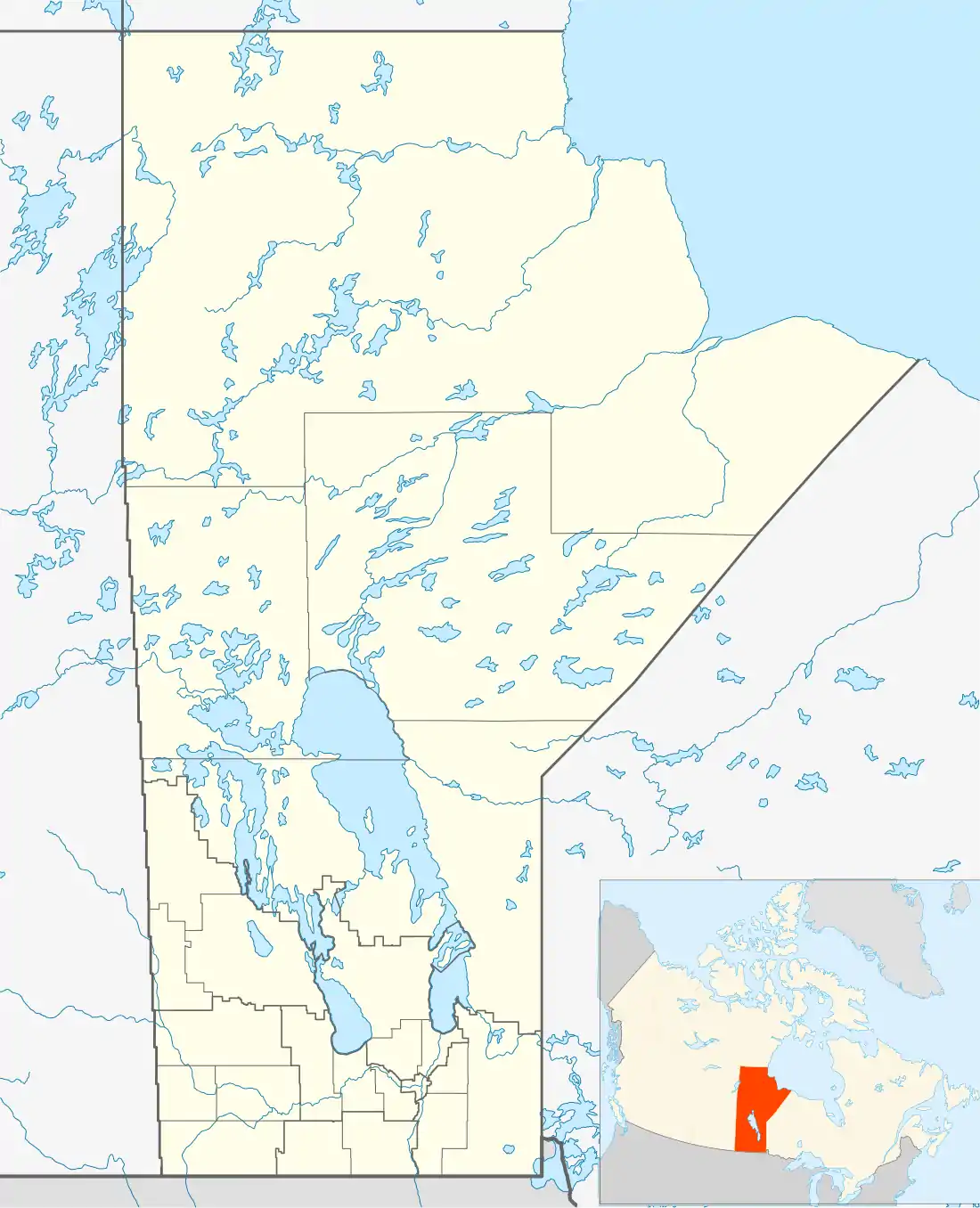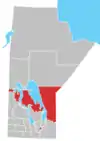Sagkeeng First Nation
The Sagkeeng First Nation is an Anishinaabe First Nation that holds territory in the southern part of Lake Winnipeg, Manitoba, Canada, 120 kilometers north of the city of Winnipeg ("Win-nipi" is a Cree word meaning "murky waters"), and on the mainland. The Sagkeeng reserve, once called Fort Alexander, has a total population of 7,637 registered band members, with 4,285 members living off reserve. The name "Sagkeeng" is derived from the Ojibwe language Zaagiing, meaning "at the outlet".[1]:14 The Reserve is located on both North and South shores "at the outlet" or mouth of the Winnipeg River. It is adjacent to the northern border of the Rural Municipality of Alexander, which also borders the Town of Pine Falls.
Fort Alexander, Manitoba
Sagkeeng - Mouth of the river[1]:14 | |
|---|---|
| Coordinates: 50°36′32″N 96°17′44″W | |
| Country | |
| Population | |
| • Total | 7,637 |
Sagkeeng’s traditional territory includes land within Treaty 1 and lands north and east of the Winnipeg River. The territory of Sagkeeng originally was to have commenced one mile upstream from the Fort Alexander trading post formerly occupied by the Hudson’s Bay Company. Indigenous and Northern Affairs Canada (INAC) files indicate the Chief and Council requested the boundaries to be moved to its present location.
History
Sagkeeng Ojibway people
This ancient (Ft. Alex) gathering and trading area and its peoples were a component of the copper culture, as evident by copper points and artifacts that were found in what became the Ft. Alex area. The source of the copper was the Lake Superior copper mines that are thousands of years old.
Some of the Sagkeeng Ojibway people are direct descendants of the Anishinaabe tribes that migrated from a very ancient settlement in the present-day Sault Ste. Marie, Ontario area. Some of the forefathers of Sagkeeng were a component of the ancient copper culture; they brought the copper points and artifacts that have been found around the Fort Alexander fishing, hunting, trading, and meeting grounds.
According to the current Sagkeeng government, Sagkeeng Anishinaabe have lived "at or near the mouth of the Winnipeg river (which became Fort Alexander Reserve #3" and Traverse Bay, since time immemorial."[2] This means that some Sagkeeng forefathers were always from this area and they mixed, married, and traded daughters with Anishinaabe and other native tribes. The Anishinaabe peoples began trading with the first French immigrants just a few hundred years ago in this Fort Alexander area now known as Sagkeeng territory.
Fort Alexander
In 1734, La Vérendrye built a fur trading post, Fort Maurepas, on the north side of the Winnipeg River, north of present-day Selkirk, Manitoba; which was abandoned at the end of the colonial period. Later Toussaint Lesieur, a North West company or NWC clerk built a post on the south side of the mouth of lake Winnipeg; it was called Fort Bas de la Rivière and functioned as the capital of the NWC Lake Winnipeg district. It became an important provisioning post for both the Native and immigrant canoe brigades. Bags of pemmican, brought from NWC posts on the upper Assiniboine River, were stored here among other goods.
The Hudson's Bay Company operated here between 1795 and 1801. In 1807, Alexander MacKay rebuilt the post on a nearby site. Beginning in 1808, the new post was known as Fort Alexander (50°36′32″N 96°17′44″W). Since big game of the area had been over exploited by immigrants in the late 1700s, fish, grains and garden vegetables were the staple foods of the area. By 1812, the Bas de la Rivière gardens were selling vegetables to the incoming Red River immigrants. After the Northwest and Hudson's Bay companies merged in 1821, Fort Alexander continued to be operated as a trading post for the natives and immigrants in the region.
Contemporary life
The nation has a dance group Sagkeeng's Finest, who won the 2012 first and only season of Canada's Got Talent.[3][4] The group included Vincent O’Laney, 17, and brothers Dallas Courchene, 16, and Brandon Courchene, 18. They won over a total of 244 other acts. The trio started with traditional jigging, a First Nations tradition, then fused more modern dance styles, such as tap dancing, into their act. Because of this new style of dancing, the people of Canada took to their phones and voted "Sagkeeng's Finest" as winners of the $100,000 first prize. They also won a $105,000 Nissan GT-R sports car, an opportunity to perform during City TV's New Year's Eve special, and the possibility of performing at a venue in Las Vegas.
Rogers Media’s Scott Moore said the victory for Sagkeeng’s Finest showed Canadian support for an underdog. “It shows the diversity and the acceptance of Canada,” he insisted.[5][6][7]
Other notable members of Sagkeeng First Nation include artist and curator Jaimie Issac.[8]
Treaty
Kakakepenaise (Gekeki-Binesi, "Hawk-bird", a.k.a. William Mann I) signed Treaty 1 in 1871 on behalf of the Sagkeeng people.[9] Although Sagkeeng is a Treaty 1 nation, Sagkeeng is unique among other Anishinaabe communities, as it a member of Treaty 1, Treaty 2, and Treaty 3. All three treaty boundaries merge at Sagkeeng. Which means it is a member of the Grand Council of Treaty 3 (GCT3). These encompass a geographical area of 55,000 square miles. The Northern Territory of Turtle Island, the Southern Plains territory, and the Eastern Turtle Island territory treaty boundaries all converge at the Sagkeeng Territory.
The GCT3 is a political organization representing 23 First Nation communities across Treaty 3 areas of northern Ontario and southeastern Manitoba, Canada. Along with the Southern Plains, they represent an additional five First Nations in specific regards to their Treaty rights. Sagkeeng holds its annual Treaty Days in the last week of July of every year. The five to six days of events are open to everyone and include a community parade, various children's events, a three-day Pow Wow, and, lastly, fireworks.
The French Oblates of Mary Immaculate nuns ran the Fort Alexander residential school for Indigenous children. As was the ignorance and cruelty at the time, the teachers practised cultural Genocide and forced the students to speak English and prohibited them from practicing their own culture in their own land. The French nuns created a legacy of pain and suffering among the Anishinabe people who continue to heal from this abuse to this day.[10]
In 2005, the Canadian Government formally acknowledged and apologized for the abuses of the residential schools. In 2007, it authorized payment of a $1.9-billion compensation package to surviving children who had been forced to attend the schools.
The Sakgeeng and other Indigenous peoples have criticized the government's Child and Family Services (CFS) for breaking up families, rather than working to hold them together by providing support to parents and children.
Virginia Fontaine Addictions Foundation Scandal
On October 18, 2000, Canadian Press organization reported that the Director of the Foundation, Perry Fontaine (who was eventually charged with fraud over $5,000 and sentenced to three years in Federal prison) and 74 other foundation staff attended a cruise to the Caribbean that was termed a "Staff Retreat". This treatment center (now called the Sagkeeng Mino Pimatiziwin Family Treatment Center) is located on Sagkeeng First Nation and the "Staff Retreat" required the then Addictions center be closed.
The cost of this trip was reported later to be over 135,000 dollars. Health Canada eventually investigated the financial books of the Center and found massive fraud and kickback schemes which was oversaw by former Health Canada assistant deputy minister Paul Cochrane and Patrick Nottingham, the ex-regional director of Health Canada’s First Nations and Inuit health programs in Manitoba. Cochrane and Nottingham pleaded guilty in the fall of 2005. Cochrane was formally accused by the RCMP, after more than two years of financial mismanagement at the center was eventually charged with one count of breach of trust and seven counts of fraud against the government. Nottingham, was given a conditional sentence of two years less a day and ordered to pay $1.14 million in restitution.
According to the RCMP, Perry Fontaine along with his wife and daughter offered bribes to Cochrane, who accepted a $50,000 payment on Dec. 11, 1996; four season's tickets for NHL hockey games in Ottawa in 1998, 1999 and 2000; a blue 1997 Jeep Cherokee sport-utility vehicle in April, 1998; a red 1997 Jeep Grand Cherokee in July, 1999; a green 2000 Nissan Xterra sport-utility vehicle for his son Lucas Cochrane in May, 2000; free trips for Cochrane and his family between July, 1999, and October, 2000; and two income tax receipts for fake donations of $5,000 each for the years 1997 and 1998. Cochrane sons were also given cushy, well paying jobs at the center at his insistence.[11][12][13]
Sagkeeng First Nation now hosts a family treatment center, the Sagkeeng Mino Pimatiziwin Family Treatment Center. The program has been successfully running for a few years. They work with entire families to learn how to work through problems and keep families together.
Murder of Serena McKay
In April 2017 nineteen year old Serena McKay was brutally murdered by two of her classmates from Sagkeeng Anicinabe High School . A cellphone video of the murder was posted to social media, with the attack receiving widespread attention and condemnation. Two unnamed girls were later convicted of murder and manslaughter respectively in relation to the crime.[14][15][16]
References
- "Traditional First Nation community names" (PDF), Manitoba First Nations Education Resource Centre Inc., Principal's Newsletter, February 2009, retrieved July 15, 2016
- "History - Sagkeeng First Nation". www.sagkeeng.ca.
- "" 'Canada's Got Talent' Recap: Sakgeeng's Finest Wins", The Star
- "Sakgeeng's Finest get ready for prime time", Winnipeg Free Press
- "Canada’s Got Talent recap: Sagkeeng’s Finest wins", Toronto Star
- "Sagkeeng's Finest get ready for prime time", Winnipeg Free Press
- Sagkeeng’s Finest – Pride of Manitoba Archived 2013-01-15 at the Wayback Machine, Manitoba Chiefs
- "Winnipeg Art Gallery gets new curator, upcoming exhibit | Metro Winnipeg". metronews.ca. Retrieved 2018-04-05.
- "Sagkeeng History and Timeline".
- "Canada's Forced Schooling of Aboriginal Children Was Cultural Genocide, Report Finds", New York Times, 3 June 2015
- "Former director of Manitoba native treatment center jailed". CBC. June 19, 2009. Retrieved 20 January 2018.
- "Civil Servant well travelled". Globe and Mail. December 18, 2000. Retrieved 20 January 2018.
- "Health Canada - Virginia Fontaine Addictions Foundation Funding Report". Health Canada. Archived from the original on 7 June 2011. Retrieved 20 January 2018.CS1 maint: bot: original URL status unknown (link)
- https://www.cbc.ca/news/canada/manitoba/suspicious-death-sagkeeng-rcmp-1.4084181
- https://www.cbc.ca/news/canada/manitoba/serena-mckay-murder-1.4465484
- "Teen pleads guilty in Manitoba woman's fatal beating" – via The Globe and Mail.
External links
- Sagkeeng First Nation
- Health Canada Virginia Fontaine Addictions Foundation Funding Report
- AANDC profile
- Map of Fort Alexander 3 at Stat can

